Submitted by Tarun Bhasin
Housing & Provisioning Services: Co-Production Strategies for India amidst COVID-19 Outbreak
India Architecture News - May 30, 2020 - 18:25 6848 views
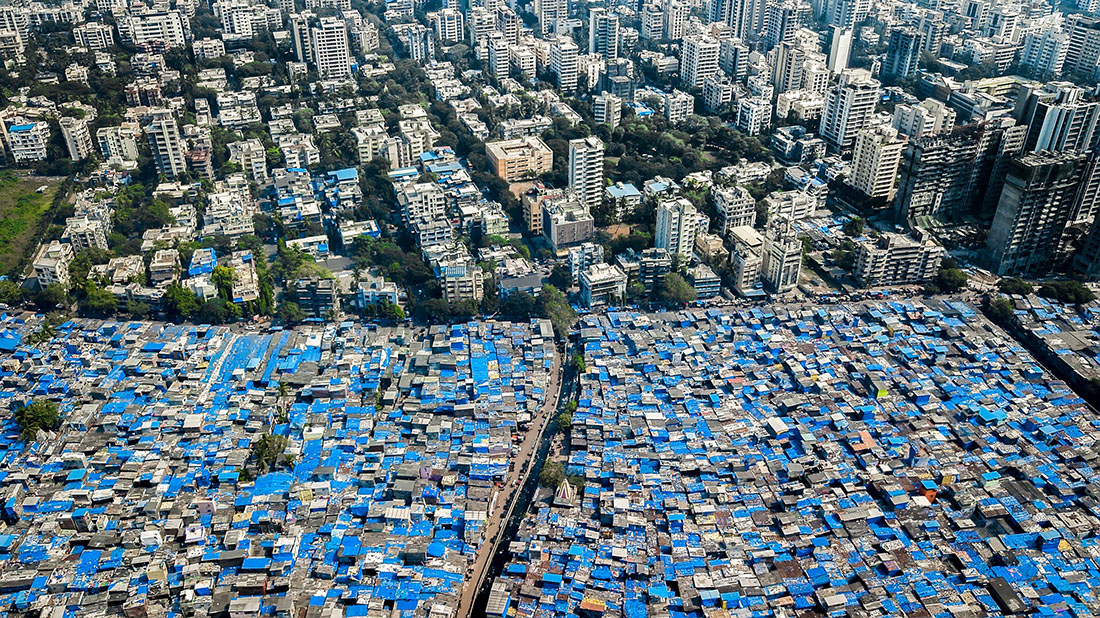
The following essay is written in light of the current internal (reverse) migration crisis in India actuated by the country-wide lockdown put in place as a result of the Government of India's strategy to mitigate and prevent the onslaught of COVID-19 pandemic. The essay tries to understand the deep-rooted systemic faultlines and mechanisms that contribute to spatial injustice in our cities, which create conditions for such a crisis to occur. It discusses how co-production as a strategy for creating a viable market for provisioning services (such as food, water, sewerage, energy, green spaces, markets, roads, etc.) is not only desirable but inevitable. Furthermore, it discusses the link between social movements and housing free-market that helps in creating a favorable housing environment and actuating processes of co-production; and why strengthening this link and the perceptual notion is crucial in developing multi-faceted housing solutions in the future if we wish to really achieve the vision set by the ambitious mission - Housing for All 2022.
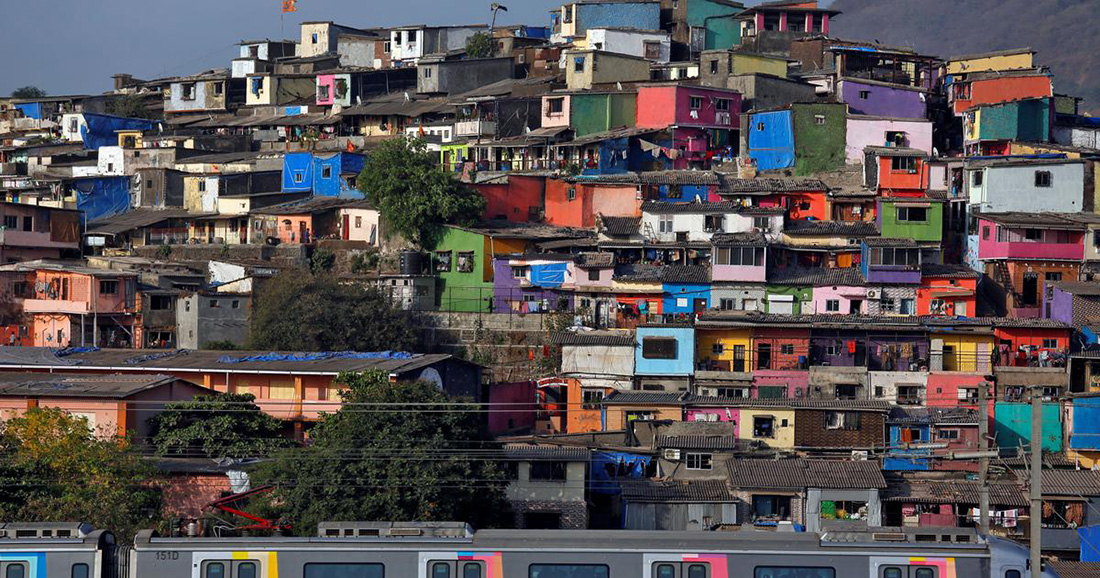
Image Credit: Scroll India.[1]
Opening Remarks
While understanding the concept of Ecosystem Services (ES) and their various classifications, going by the definitions provided by Millennium Ecosystem Assessment, one concept that bridges all human activity is that natural or semi-natural ecosystems need to be looked through the lens of enhancing human well-being. And amongst their various typologies, two typologies cut through all spatial domains of urban, rural or rurban – Habitat Functions (shelter) and Regulation/Provisioning Functions (water, air, food, sewage, and energy). (de Groot et. al., 2002) It is thus safe to assume that the scale of shelter and provisioning services is a species-wide phenomenon, beyond only the purview of anthropology, spatial agencies, participatory practices, and politics, or perhaps, all these forms of knowledge fundamentally deal with the understanding and governance of the two typologies of ES. Nevertheless, if the two typologies are considered in their own right, they establish the notion of cities as purely man-made ecosystems – ecosystems nonetheless – and the notion legitimizes the need for improved shelter and access to provisioning services in towns and cities in the Global South, which collectively face a shortage of these services for some 900 million residents. (UN-Habitat, 2003)
Since shelter and provisioning services come under the ambit of an ecosystem, logically and practically, it is especially in the case of cities, not under the capacity of an individual or even a family to fetch these services for themselves without the help of the system. Rising incomes do not necessarily ensure enhanced shelter conditions, since, in case of regulatory absence and prevalence of informality, the provisioning services are also largely informal. These services become a method for low-income citizens to negotiate with the state, and for the state, they act as a channel to enact strategies that help them relate their policies to low-income communities. Therefore, going by this definition of creation of cities in the Global South, fundamentally on the need of providing shelter and provisioning services, in absence of the capacity of the state to do so by itself, is it safe to assume that a large part of public services is jointly produced by the citizens and the state, with at least one or more elements that are a part of these ES being jointly shared by the two sides, with the primary consideration to improve the delivery of the means and ends of their services? If yes, going by the logic of cities as man-made ecosystems, isn’t coproduction an already better-placed method of governance? (Mitlin, 2008)
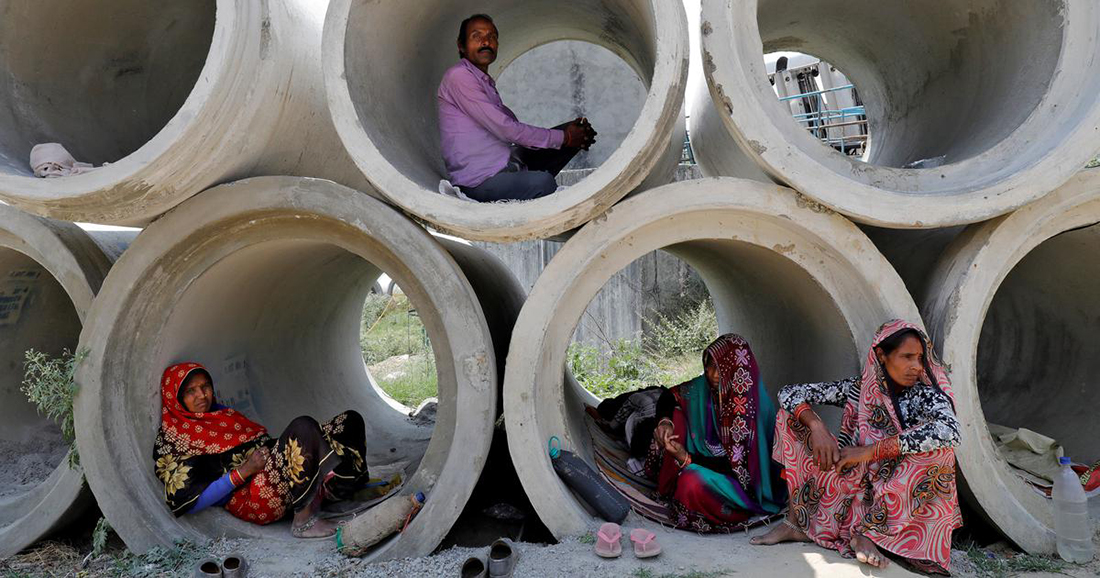
Image Credit: Scroll India.[2]
Systemic Deficiencies
It is not just the spatial characteristics, but the inability of provisioning services to be allowed to flourish freely in the cash-heavy economy, by de-legitimizing the right of individuals or groups to act on them, that is the main cause of denial of political rights to the urban poor that will grant them the adequate shelters they need. (Meikle, 2002) Perhaps, this is why Patrick Schumacher at World Architecture Festival 2016 in Berlin, did not refrain from causing a stir, when he called for getting “getting rid of regulations, privatizing all public space and scrapping social housing”. His key takeaway was as follows “We do not have a real market in the real-estate provision, that's why we have a housing crisis. Housing for [All] can only be provided by the freely self-regulating and self-motivating market processes.” (Frearson, 2020)
His remarks, although meant for social housing laws and regulations in London, is relevant to any geography where governmental regulations and provisioning dictate the means of production of housing in a market. Thus, it is important to draw its relevance in the Indian context where much of the housing policies are based on outdated socialist norms and detract economic intervention. Here, it is important to note that urban poverty is academically accepted as a created and maintained phenomenon since it requires for a person to enter the labor market and have an income within highly commodified and complex economies of cities, which at the first glance can be considered the basis of valuing the contribution of an individual in a free-market economy; while one of the problems that according to socialist or communist ideologies are the source of inequality; but nevertheless a historically proven method of generating wealth. (Peterson et. al., 2019) (Novara Media, 2019)
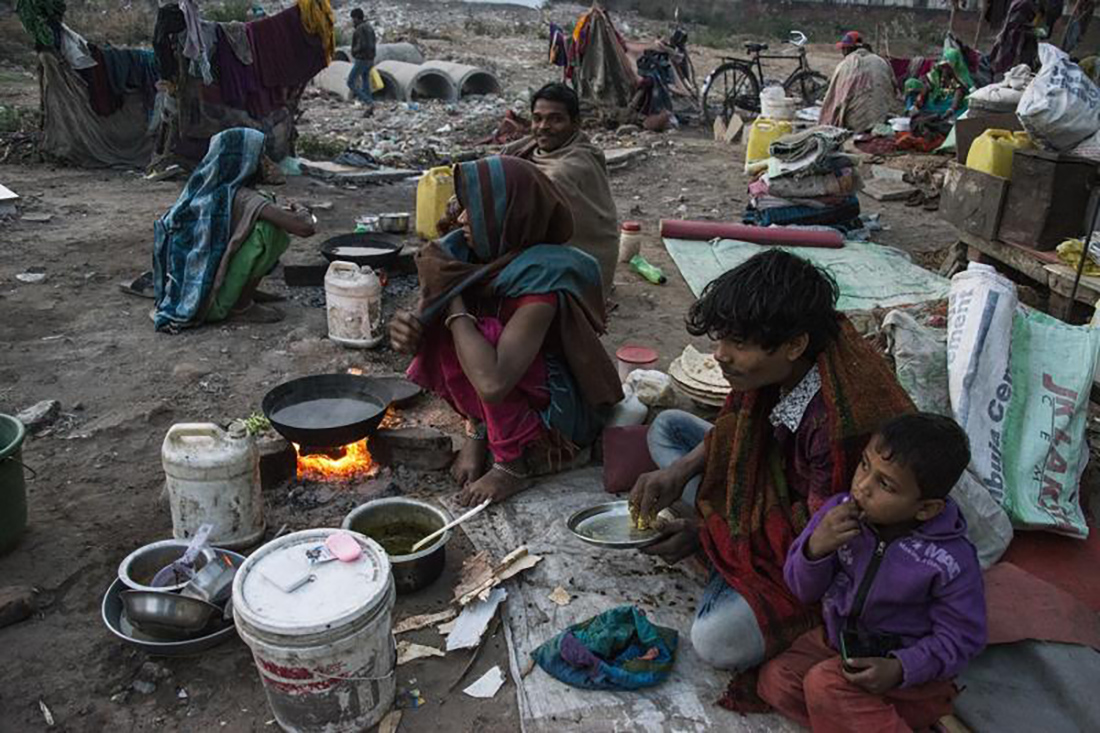
Image Credit: The Wire.[3]
However, we further note that, if low income was truly the problem, then rising incomes would allow urban poor to move beyond current spatial conditions, a necessary step in the creation of individual or family wealth. But, existing studies continuously provide evidence that rising income alone rarely results in improvements in the well-being of individuals or communities in question. It is actually the denial of provisioning services, discrimination in the value of labor and stated commodities, and lack of political or civil rights to legitimize the production and distribution of provisioning services in the free-market economy; that ensure the continuance of urban poverty. (Hardoy et. al., 2001)
It is validated by the observation that most co-production strategies have focused on addressing provisioning services. The deficiencies in provisioning services and their systems are well documented and are not confined to poor nations or small urban centers. On one hand, while it restricts the higher-income dwellers from finding better housing opportunities, it exploits the poor since they have to spend a large portion of their income on fetching basic services such as food, water, sanitation, etc. from private sources, that due to lack of market or legitimization provide inadequate quality at high prices. (McGranahan et. al., 2006) Furthermore, identity aspects related to residency, further classify urban poor under the ambit of ‘illegality’ excluding them from larger social, economic and cultural processes of the city by normalizing their situation as one caused by their own wrong-doing and not a result of unfair market policies, thus, aggravating their vulnerability in face of an atmosphere of socio-economic and legal abuse and exploitation. (Brown, 2006)
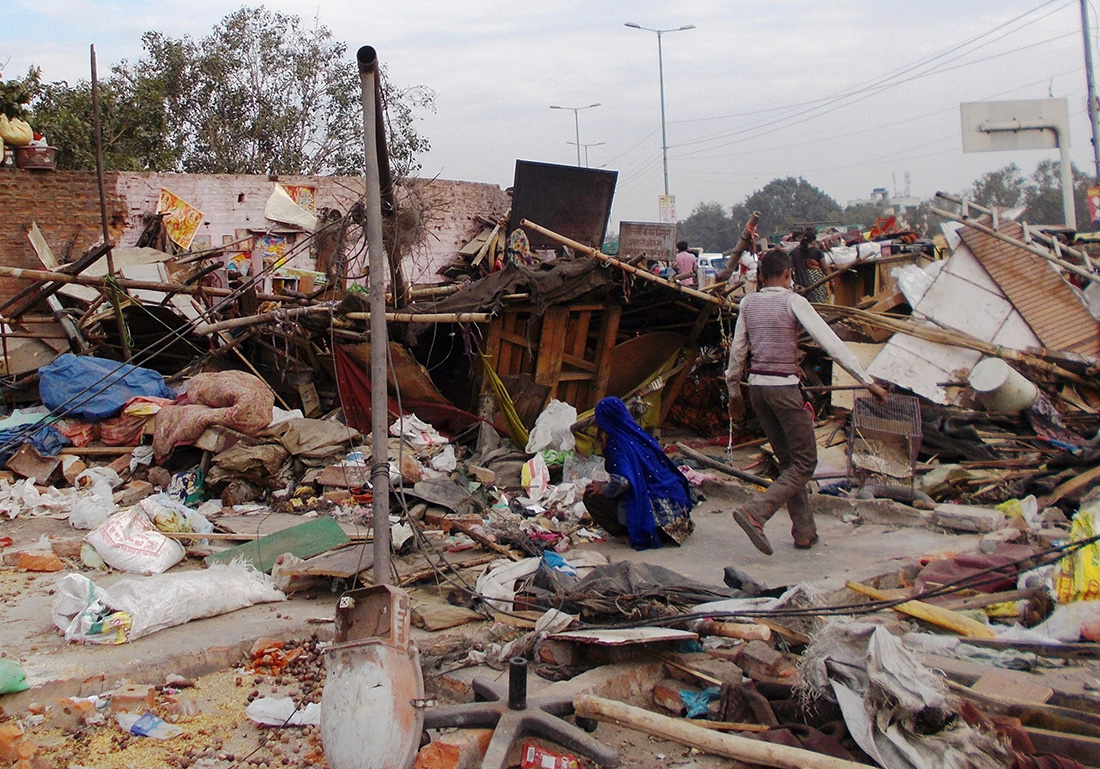
Image Credit: MIT (Massachusetts Institute of Technology) - DRAN (Displacement Research and Action Network).[4]
Natural Responses
Drawing on acute systemic deficiencies and governmental incapacity that lead to financial constraints, social unwillingness to address needs, high level of informality, and commodification, urban poor use various strategies and development options to tipping the decision-making processes in their favor. These responses, if viewed from a point of assigning values to the resources and services and their distribution, highlight the ecological, socio-cultural, and economic values gained for the entire geography by addressing the needs of the urban poor. (Limburg et. al., 1999) In this another form of ES, that is Information Functions, related to the socio-economic value concepts (such as equity, equality, fairness, etc.) plays an important role in defining socio-natural relationships (normalizing the acceptable forms and conditions of a dwelling in an urban environment), identifying and emphasizing on physical/mental health, education, spiritual values, cultural diversity, etc. as notions that are indispensable to a sustainable society. (Norton, 1987)
This, in turn, creates a contingent value for these resources or services in the political spectrum and hands some bargaining power to the poor in front of the government, since they become the center point of the larger public discourse on planning and management of urban areas. This contingent value can be classified, in economic terms as Willingness to Accept Compensation (WTA) or Willingness to Pay (WTP) for the absence or availability of these services, which automatically validates the need of provisioning services to remain in the free-market domain, thus, opening the doors of negotiation and reproduction. (Jacobs, 1997)
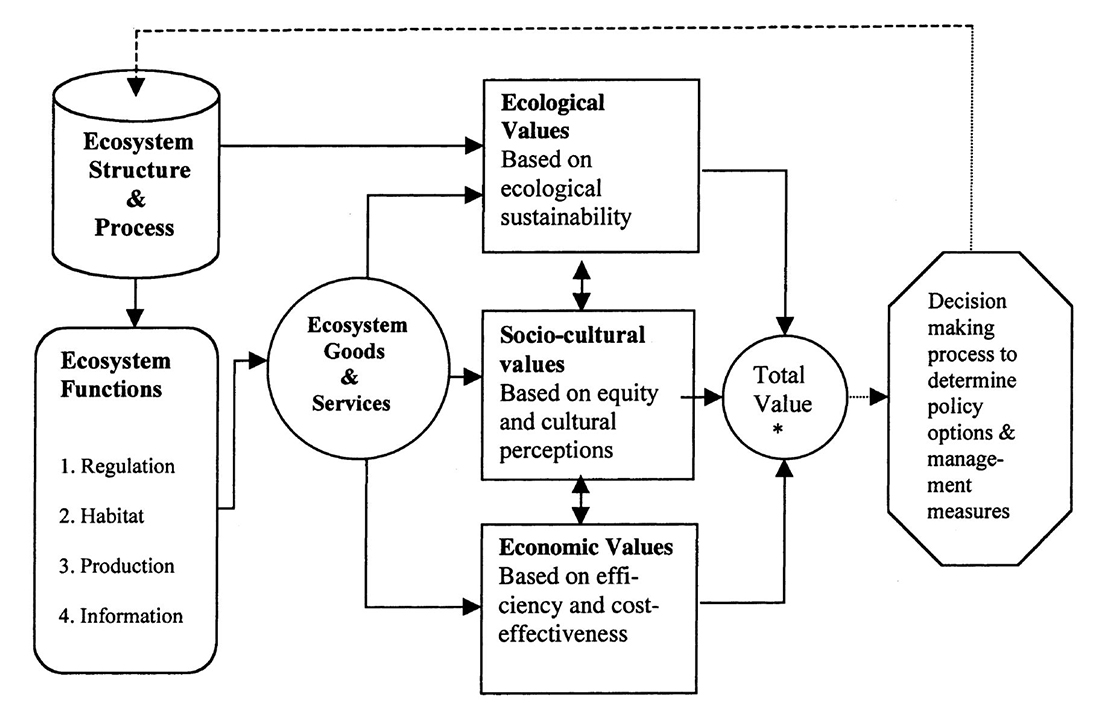
Image Credit: Taken from (de Groot, Wilson, and Boumans, 2002).[5]
These forms of negotiation pan out in specific forms. The first forms of strategies are direct-market based strategies that involve participation at the individual, household, or collective self-help communities level and are largely related to the last form of ES left to be mentioned i.e. Production Functions. These focus on individual advancement, by means of social capital, entrepreneurship, innovation, and support, within the existing structures and systems, by offering collective goods and services. Sometimes, these strategies happen in the complete absence of the state. (Mitlin, 2007) Microfinancing is perhaps one of the most relevant, popular, and successful examples in the domain. Other commonplace self-help activities amongst low-income and informal settlements include improvement of drainage, reduction in water stagnation, creation of common garbage dumps, provisioning of solar electricity, etc. Even these require some form of collective action and in most cases gain some assistance from forms of governance prevalent in the area, but are completely absent in case of squatter settlements in their formative years as a measure by the communities living there to preserve their autonomy. (Castells, 1983)
The secondary forms of negotiation are in-direct market-based strategies that can also be referred to as clientelist politics. This does not involve the improvement of the existing situation but a more collaborative approach where the poor seek particular patronage to pay for the goods and services they need. This leads to the consumption of said goods and services, nonetheless, they remain uncertain and thus, lack market innovation or improvement over time. This is the form, that due to the allocation of resources through obscure and translucent channels, takes away certain entitlements over provisioning services and hands it to a few powerful groups. This creates further exclusion, that renders the urban poor resorting to crime to obtain those resources, thus stretching the political spectrum in public discourse and bringing back the focus on notions mentioned under Information Functions. (Abers, 1998)
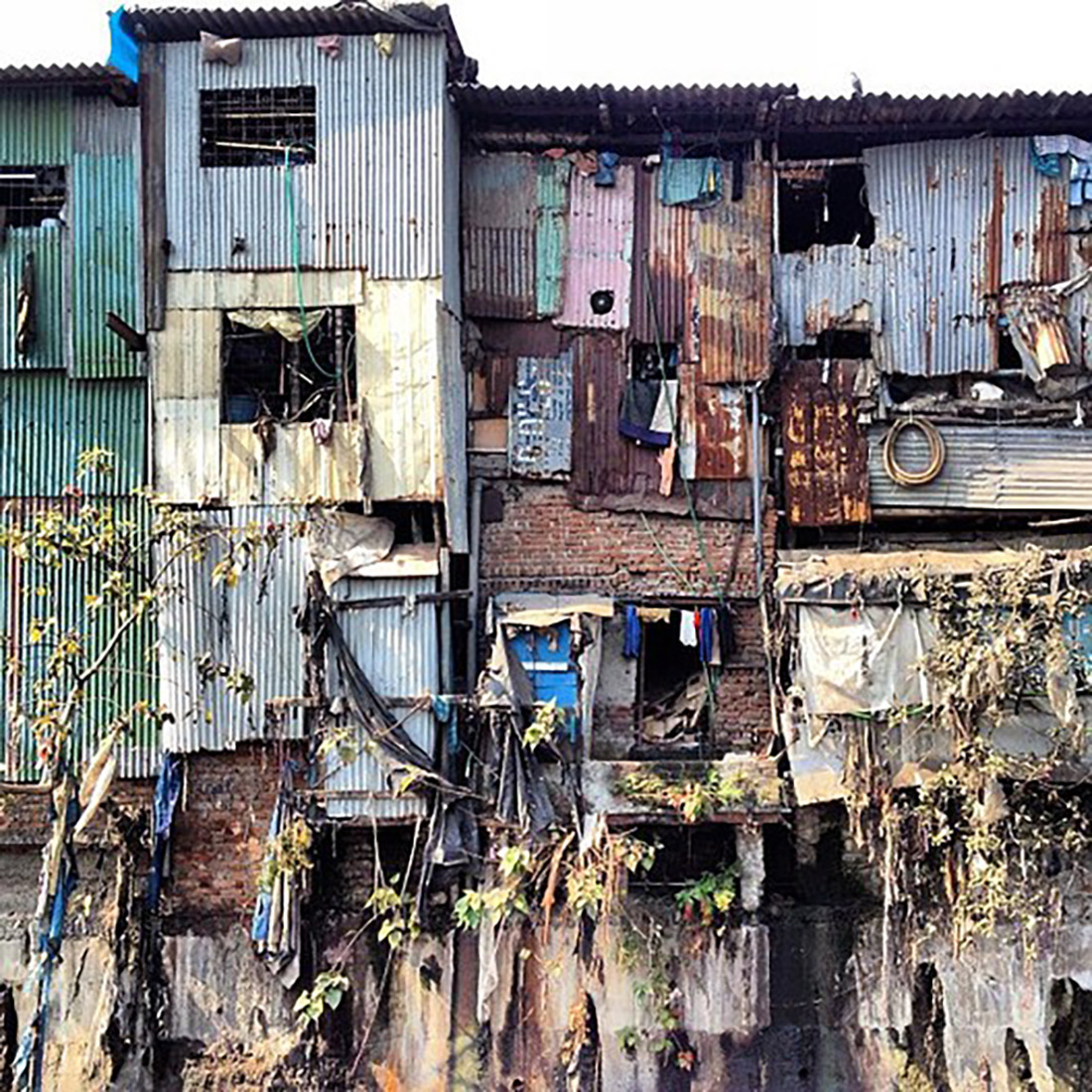
Image Credit: Noelia Morales.[6]
The tertiary form of negotiation are social movements, and they have the most to gain out of it. Since, before the establishment of the need for co-production of a free-market system, social acceptability and demand have to be ascertained, thus, social movement groups almost always come out on top through politicized mass action of urban poor based around income security, asset creation/safeguarding, and identity. (Mitlin et. al., 2006) Most demands from social processes are collective in nature and rarely do citizens deviate from the alliances and coalitions to indulge in organic activities that voice their individual needs; although, perhaps, on an everyday basis they might not be as politically explicit as in the case of developed/modern nations they certainly do involve some level of engagement between the citizen and the state. (Kabeer, 2002)
The motivation to opt for coproduction as a tool goes beyond improving the efficiency of the service or its functionality, rather, it primarily services to motivate the locals and strengthen their organization and serve as a crucial platform for greater and more comprehensive civic engagement and political mainstreaming by (and of) the urban poor. (Evans, 1996) This synergy is relevant across the citizens, the social movements and the state in the implicit everyday arrangements highlighting the fundamental human needs and aspirations towards access and opportunity to take part in the production-consumption processes and redistribution of resources (and power), and conclusively, participation in a fair and free market and political inclusion in decision-making processes of the city – both of which require mass organization and skilled negotiation in hope for improved outcomes, achieved only through means of social movements – hence, they come out on top in all of the natural responses co-opted by (and for) the urban poor. (Moore, 2003)
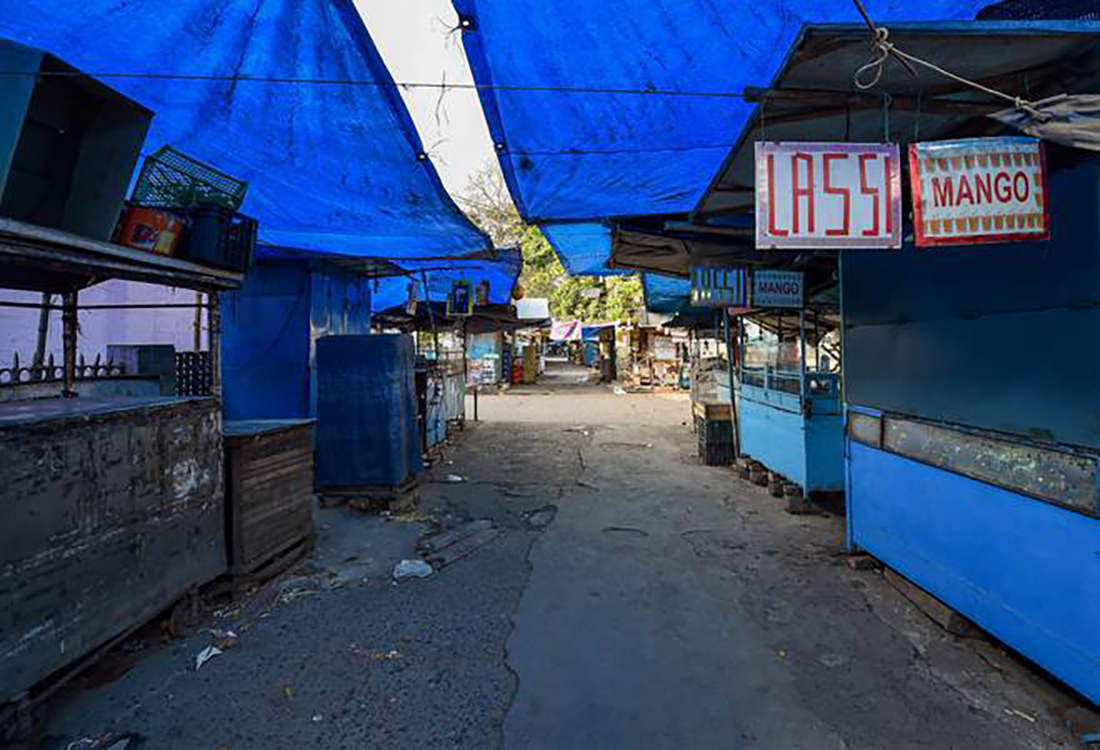
Image Credit: Business Today.[7]
Social Movements
Research evidence constantly suggests in case of Global South, due to low state capacity to provide for the needs of its citizens and high informality as a lived reality, as in the case of North as well, that an authoritative bureaucracy faces systemic deficiencies that stymies its rate of progress and development, pushing it to negotiate with citizens to ensure participation. This engagement is not limited to one-off decisions related to certain changes but a larger acceptance of the notion that there are certain processes that are best resolved locally with citizen engagement, encouraging citizen groups to take more collective self-help action. (Whitaker, 1980)
Over time, the dynamism of grassroots co-production movements has a tendency to move beyond local issues to more substantive ones based around collective consumption, negotiating for locals greater control over processes and resources, through a sustained deliberate dialogue with the state. This is achieved through a triad of local action in provisioning resources and services, constant deliberate discussions with the state, and trans-neighborhood/community networking. This dynamism seems to suggest that grassroots co-production is not only favorable in the political outcome it generates for the poor, but it also enhances the nature of the groups by extension of political practice, leadership experience and expertise to the poor, while also persuading the state to act more responsively and positively towards its citizens. (Muller et. al., 2007)
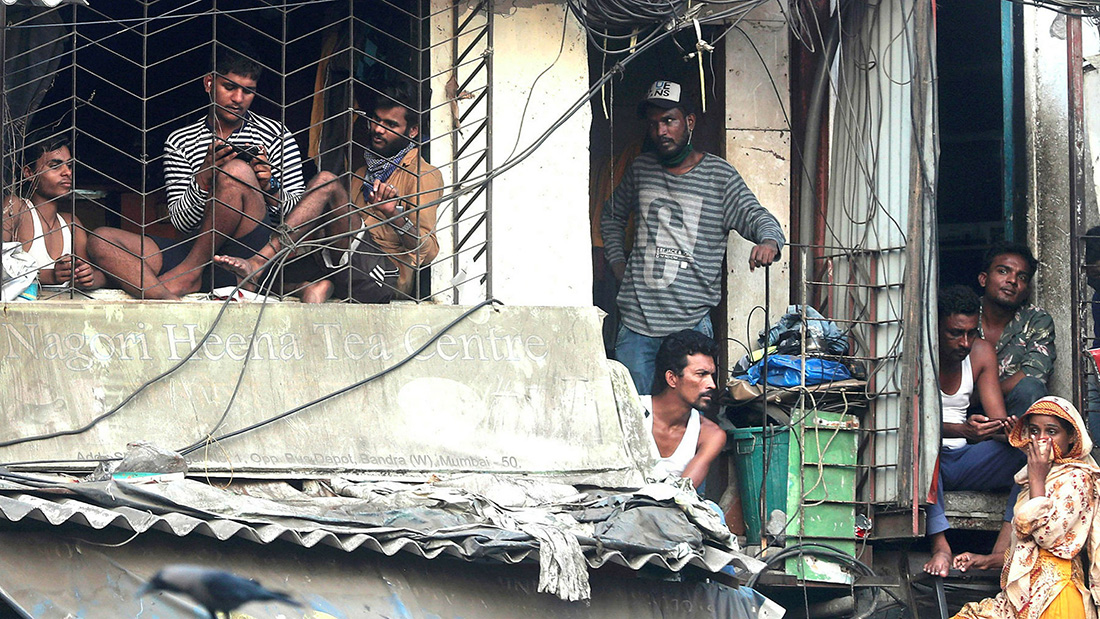
Image Credit: Financial Times.[8]
Therefore, they resolve a paradox. In modern democracies, state agencies see themselves as key legitimately elected stakeholders controlling activities, promoting authority (and superficial participation in micro-management issues only,) deviating from the principles of a democratic collective that is based on successful community involvement. In such a scenario, grassroots co-production brings accountability and redistribution of power for effective and transparent local services that become available to all citizens through democratic practice, highlighting a need to participate and include those in need. (Appadurai, 2001) Through day-to-day interactions and orienting the people towards the idea of self-reliance, they change the socio-economic behavior – at one end pushing the citizens to produce more and on the other resisting central political forces in order to force the state to act at the community level to deliver on its responsibilities. (Castells, 1983) They also showcase modern responses to the questions around democratic will, always speculating whether the grassroots leadership itself will undergo the transformation and choose to contest on alternative political issues as a political party. (Joshi et. al., 2004)
The state itself can act as an initiator of coproduction, in face of lack of social capital or skilled local organizations. While Evans claims it to be “competent engaged set of public institutions”; (Evans, 1996) Bovaird highlights how sympathetic political elite play a pivotal role in establishing contestation to select people to deliver on forms of reproduction; (Bovaird, 2007) and Ackerman reflects on the importance of a reformist bureaucracy by saying that the “supply side of the equation is crucial. Without capacity and well-financed state apparatus that can actually respond to popular demands and participation, such accountability mechanisms would create more disenchantment than hope.” (Barbosa et. al., 1997) However, Milton’s analysis suggests the state actually positions itself to take an ambivalent role in the entire debacle, on one hand helping to elevate the incomes of the poor, but at the same time targeting grassroots co-production movements constantly. (Mitlin, 2008)
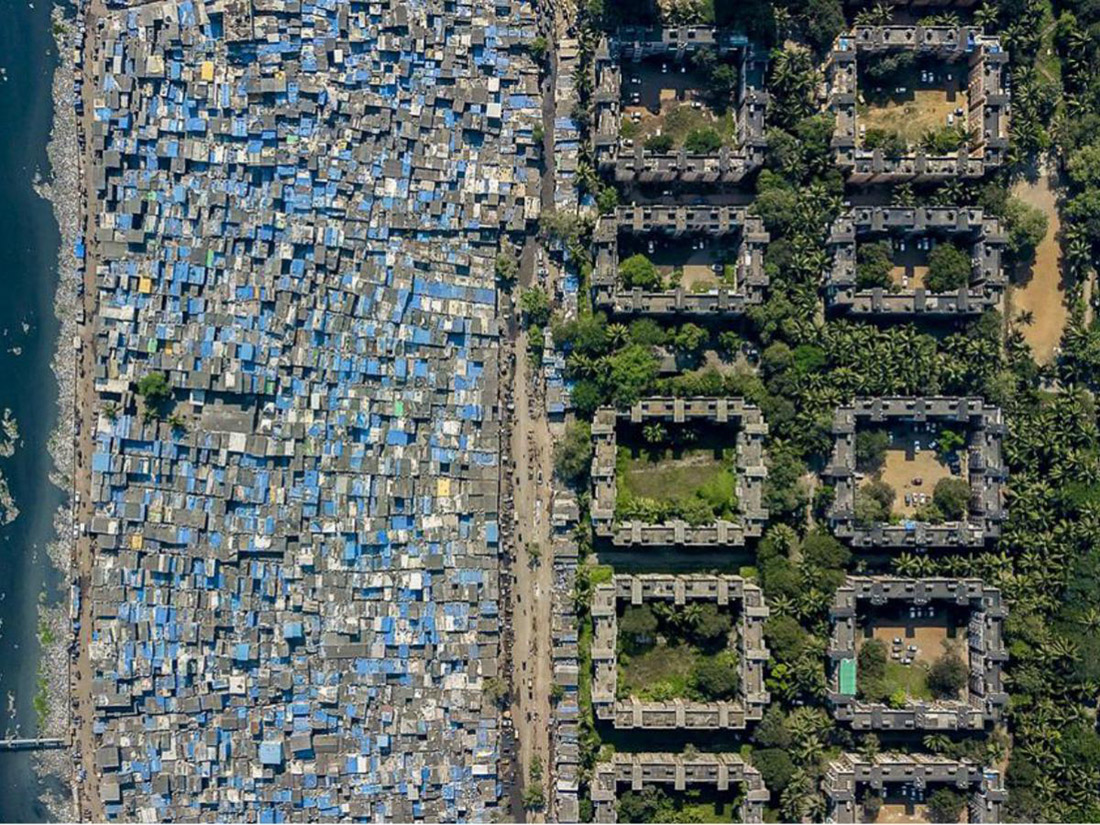
Image Credit: Quartz India.[9]
Perhaps, it is the push of indirect market forces and the clientelist politics that lobby within the state to regain control over resources, to maintain resource scarcity, oppose free-market and drive the contingent rates to services high in order to enact their political interests and economic will. There is another apprehension on behalf of the bureaucracy that inclusion of communities and a shift from a more collaborative model to the one based on co-production might lead to loss of standards in the decision-making processes and in turn, the services themselves. (Baumann et. al., 2001)
Through a Foucaldian analysis on governmentality and state power the message is clear on the idea of co-production – it is a tool, regardless of the actors promoting it, that strengthens the capacity of civil society by strengthening collective practice by teaching the participating groups new things that contribute to their collective knowledge, and ways of acting and resisting individualization of ideas and values, by increasing the density of the network of participants and enhancing social consciousness amongst them. It also provides a political arena to challenge and contest undesirable forms, systems, and dimensions of governmentality and corrects the concepts and rationale through which public services are accessed by the poor. And as these social movements gain or create newer forms of knowledge, its participants, mostly the poor excluded citizens, begin replacing and occupying the spaces of governmentality in their own right. (Foucault, 1978)
Thus, co-production develops and sustains not just because of immediate benefits to provisioning services operations and its industry at large by necessitating a free-market, but also to deliver on broader political objectives that help in revamping the decision-making processes through which resources and services are delivered to the poor. It is particularly attractive to social movements because it not only organizes people at the neighborhood level but builds on the knowledge to impart a collective understanding of the mechanisms of the state to address the needs of its citizens. (Mitlin, 2008) (Frearson, 2020)
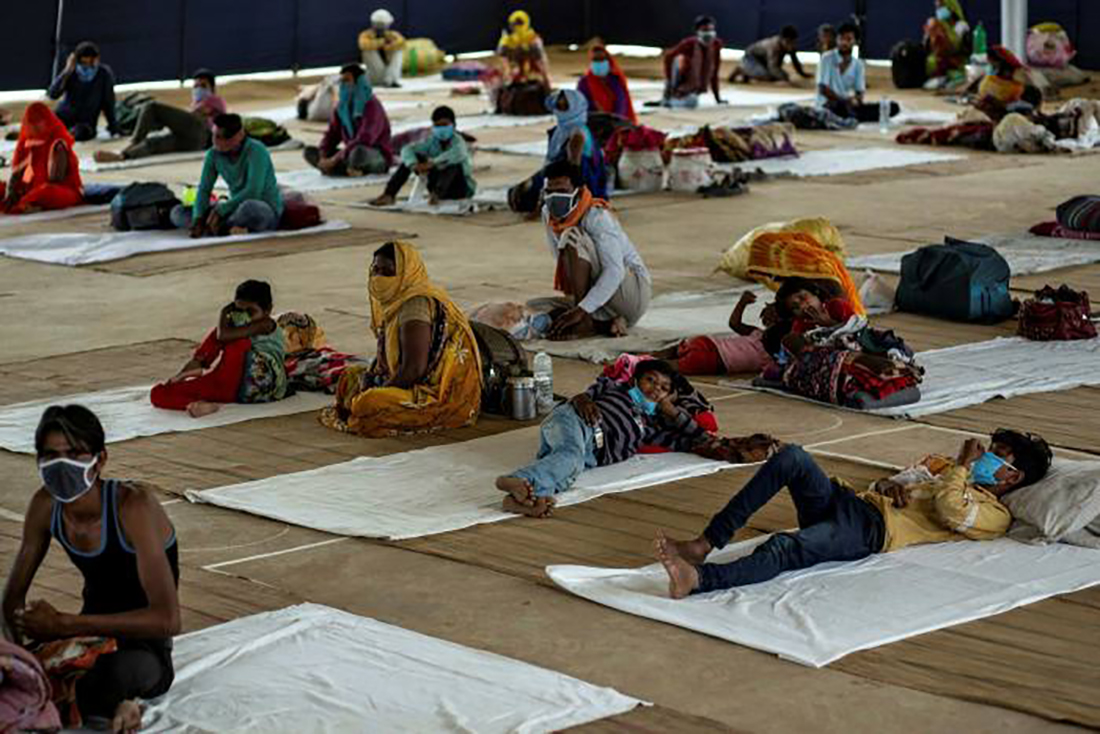
Image Credit: Reuters.[10]
Closing Remarks
“All top-down bureaucratic attempts to order the built environment via land-use plans are pragmatically and intellectually bankrupt”, coming back through Schumacher’s statement, although seemingly bold, provocative, and overstated, its logic remains. The notion of ‘Habitat’ and its various ‘Provisions/Regulations’, the social, economic and cultural ‘Information’ that surrounds its discourse, and the consequent ‘Economic’ production – the four pillars that together make up the ‘Ecosystem’ of our built environments – have as a matter of fact, always been negotiated, and built upon improving the condition of those at the bottom of the socio-economic ladder. However, the emblematic notions of community-driven and socially driven processes in pursuit of the provision of shelter and basic amenities have drawn them further away from sustainable and innovative forms of production and taken away the legitimacy from the grassroots to take part in their economy. (Peterson et. al., 2019)
Therefore, in order to adequately provide for the masses, the states in Global South inevitably will have to relinquish their power in order to re-negotiate and revitalize the forms of production of knowledge, goods, and services in order to revitalize the forms of co-production that will eventually emancipate the masses. And while social movements might be seen in contestation with the free-market forces; through academic and historic analysis present in literature, it is evident that they not only present the strongest force of action but also a tool to pivot social dialogue, orient thinking, legitimize reasoning and augment free-market mechanisms in any particular direction. The conclusion of the essay is that co-production through the use of social movements, not only binds itself to free-market forces, as a necessity but is perhaps, an inevitable phenomenon for the provisioning of sustainable built environments and 'Housing for All' in the Global South as a tool to alleviate urban poverty and help in fostering human well-being. (Novara Media, 2019)
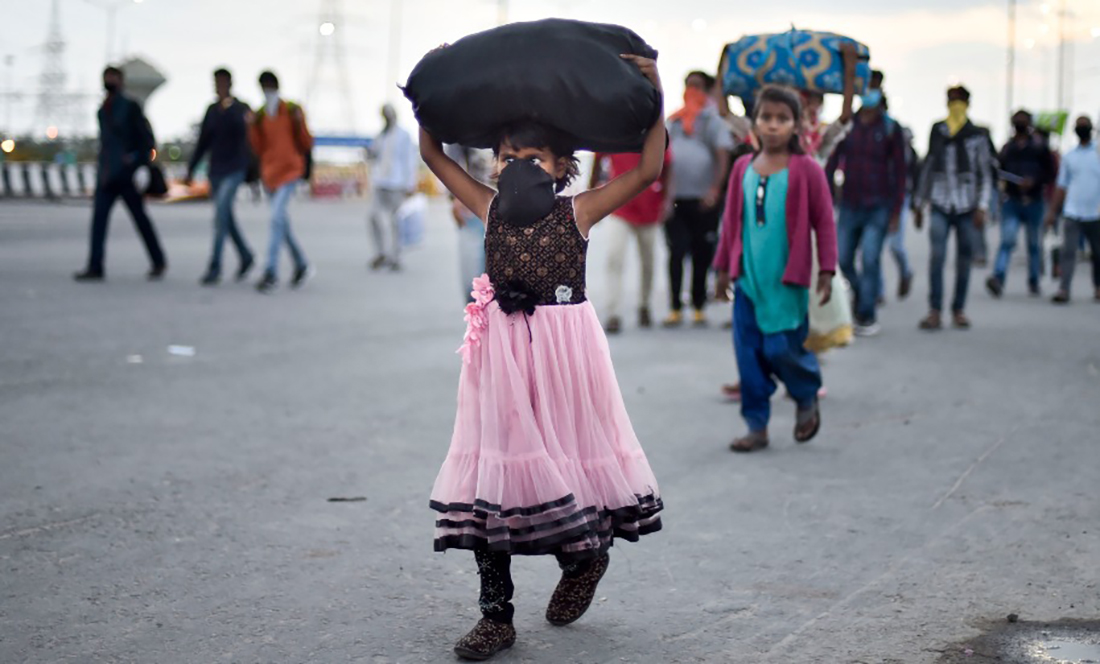
Image Credit: The Federal.[11]
Top Image: Drone Photograph of Mumbai, © Business Insider.
Bibliography
Abers, R (1998), “From clientelism to cooperation: local government, participatory policy and civil organizing in Porto Alegre, Brazil,” Politics and Society Vol 26, No 4, pages 511–537.
Appadurai, A (2001), “Deep democracy: urban governmentality and the horizon of politics”, Environment and Urbanization Vol 13, No 2, October, pages 23–43.
Barbosa, R, Y Cabannes and L Morães (1997), “Tenant today, posserio tomorrow”, Environment and Urbanization Vol 9, No 2, October, page 28.
Baumann, Ted and Joel Bolnick (2001), “Out of the frying pan into the fire: the limits of loan finance in a capital subsidy context,” Environment and Urbanization Vol 13, No 2, October, pages 103–116.
Bovaird, T (2007), “Beyond engagement and participation: user and community coproduction of public services”, Public Administration Review Vol 67, No 5, pages 857-858.
Brown, Alison (2006), “Challenging street livelihoods”, in Alison Brown (editor), Contested Space: Street Trading, Public Space and Livelihoods in Developing Cities, Intermediate Technology Publications, London, pages 3–16.
Castells, M (1983), The City and the Grassroots: A Crosscultural Theory of Urban Social Movements, Edward Arnold, London, 450 pages.
Castells, M (1983), The City and the Grassroots: A Crosscultural Theory of Urban Social Movements, Edward Arnold, London, page 277.
de Groot, R., Wilson, M. and Boumans, R. (2002). A typology for the classification, description and valuation of ecosystem functions, goods and services. Ecological Economics, [online] 41(3), pages 393-408. Available at: https://www.sciencedirect.com/science/article/pii/S0921800902000897 [Accessed 14 Nov. 2019].
Evans, P (1996), “Government action, social capital and development: reviewing the action on synergy”, World Development Vol 24, No 6, pages 1119–1132.
Evans, P (1996), “Introduction: development strategies across the public–private divide”, World Development Vol 24, No 6, pages 1033–1037.
Frearson, A. (2020). Patrik Schumacher calls for scrapping of social housing and public space. [online] Dezeen. Available at: https://www.dezeen.com/2016/11/18/patrik-schumacher-social-housing-public-space-scrapped-london-world-architecture-festival-2016/ [Accessed 12 Jan. 2020].
Hardoy, Jorge E, Diana Mitlin and David Satterthwaite (2001), Environmental Problems in an Urbanizing World: Finding Solutions for Cities in Africa, Asia and Latin America, Earthscan Publications, London, 448 pages.
Jacobs, M., 1997. Environmental valuation, deliberative democracy and public decision-making. In: Foster, J. (Ed.), Valuing Nature: Economics, Ethics and Environment. Rutledge, London, UK, pages 211–231.
Joshi, A and M Moore (2004), “Institutionalized coproduction: unorthodox public service delivery in challenging environments”, The Journal of Development Studies Vol 40, No 4, pages 31–49.
Kabeer, N (2002), “Citizenship, affi liation and exclusion: perspectives from the South”, IDS Bulletin Vol 33, No 2, pages 12–23.
Limburg, K.E., Folke, C., 1999. The ecology of ecosystem services: introduction to the special issue. Ecological Economics 29, pages 179–182.
McGranahan, G, C Njiru, M Albu, M Smith and D Mitlin (2006), How Small Water Enterprises can Contribute to the Millennium Development Goals, WEDC, University of Loughborough.
Meikle, Sheilah (2002), “The urban context and poor people”, in Carole Rakodi with Tony Lloyd-Jones (editors), Urban Livelihoods: A People-centred Approach to Reducing Poverty, Earthscan Publications, London, pages 37–51.
Michel Foucault: Beyond Structuralism and Hermeneutics, Harvester Wheatsheaf, Hemel Hempstead, pages 139–140.
Mitlin, D (2007), “Urban social movements in southern towns and cities”, Chronic Poverty Research Centre Working Paper 64, University of Manchester, Manchester.
Mitlin, D and A Bebbington (2006), “Social movements and chronic poverty across the urban–rural divide: concepts and experiences”, CPRC Working Paper Series 65, University of Manchester, Manchester.
Mitlin, D. (2008) ‘With and beyond the state — co-production as a route to political influence, power and transformation for grassroots organizations’, Environment and Urbanization, 20. doi: 10.1177/0956247808096117
Moore, M (2003), “Arguing the politics of inclusion”, in P Houtzager and M Moore (editors), Changing Paths: International Development and the New Politics of Inclusion, University of Michigan Press, Ann Arbor, pages 261–284.
Muller, A and D Mitlin (2007), “Securing inclusion: strategies for community empowerment and state redistribution”, Environment and Urbanization Vol 19, No 2, October, pages 425–440.
Norton, B.G., 1987. Why preserve natural variety? Princeton University Press, Princeton, New Jersey.
Novara Media (2019). Fully Automated Luxury Communism. [video] Available at: https://www.youtube.com/watch?v=PugN3t2QvWs&t=3408s [Accessed 12 Jan. 2020].
Peterson, J. and Zizek, S. (2019). Happiness: Capitalism Vs. Marxism. [video] Available at: https://www.youtube.com/watch?v=lsWndfzuOc4&t=1719s [Accessed 11 Jan. 2020].
UN–Habitat (2003), The Challenge of Slums: Global Report on Human Settlements 2003, Earthscan Publications, London, 310 pages.
Whitaker, G P (1980), “Co-production: citizen participation in service delivery”, Public Administration Review Vol 40, No 3, pages 240–246.
Footnotes
- While PM Awas Yojna, successfully tilted the market's outlook and direction towards affordable housing units targeting the lower-middle class population of India's urban centers, it did little to alleviate the deficiencies created by long and arduous governmental processes and paperwork required to purchase new tracts of land, offloading governmental land in costly city centers for development and corruption. Opaqueness in such policies have largely resulted in non-availability of affordable housing units in city centers, and furthermore, have failed to provide any solution to redevelop the vast tracts of slums into affordable rental housing to facilitate internal 'rurban' migrants, the ones who survive in cities on daily-wage work by living in abysmal environments, and the ones who have been affected the most in 2020.
- "In an attempt to prevent distressed workers going home due to the lockdown, the Ministry of Home Affairs issued an order on March 29 seeking that employers should pay the workers full wages and landlords should not charge rent from stranded workers. Since it was implemented without detailed planning, the lockdown put millions of low-skilled migrant workers in danger of starvation, subjected them to health risks and mental trauma as they lost the daily wages on which they depended for survival." Consequently, the meaning of housing was rendered moot in such a scenario where provisioning services weren't affordable.
- "For these migrant workers, ‘Housing for All’ represents nothing more than an impossible dream and an empty promise. Permanent houses created by schemes like PMAY in cities do not cater to the temporary and transient housing needs and imaginations of seasonal migrant workers. As mobile populations, they require temporary, dignified and affordable housing solutions in the city. Most of them have migrated to the city to earn and repay the debts they have taken in the process of building houses back in the village. They cannot afford to invest in a second home in the city, which is the only solution that the affordable housing scheme offers them."
- "Housing and Land Rights Network (HLRN) India’s most recent study, ‘Forced Evictions in India in 2017: An Alarming National Crisis’ reveals a growing trend of eviction and demolition of homes of the rural and urban poor. HLRN has identified four broad categories for which individuals and communities were forcibly removed and displaced from their homes and habitats: (1) 'City beautification’ projects and ‘slum-clearance’ (46%); (2) Infrastructure and ostensible ‘development’ projects (25%); (3) Environmental conservation and wildlife and forest protection (14%); and, (4) Disaster management efforts (8%). In almost all eviction cases, authorities did not adhere to due process. Affected communities, in many instances, were not even provided notice or time to remove belongings from their homes."
- An integrated assessment framework for the valuation of all ES functions, goods, and services with socio-cultural values taking the central role. It provides a template for the valuation of land and housing beyond design processes and ultimately provides a perceptual lens to understand the notions of a liveable environment.
- "To the residents of Dharavi, it is a way of life. They live here, work here, marry here and even die here…To the residents of high-rise buildings in Mumbai — a small but important slice of people — Dharavi is ‘Asia’s largest slum.’ A filthy place you see through a car, with windows rolled up tight…To the government, who ‘owns’ Dharavi, it is a time-bomb. Redevelopment will bring in much-needed money into state coffers. But how much of it will come into our pockets, is what they really want to know.". Dharavi became the first unsuccessful and the most aggressive case of community transmission in India's fight against COVID-19. Currently, all existing residents of Dharavi are under quarantine. Meanwhile, the state government has floated global invitation for bids for Dharavi's redevelopment.
- "In a fresh order, West Bengal government on Sunday asked authorities of every district to make adequate arrangements of temporary shelters for the poor people and migrant workers. The order was issued by state Chief Secretary Rajiva Sinha, citing a directive of the Ministry of Home Affairs for effective implementation of the lockdown measures. 'Adequate arrangements of temporary shelters and provision of food etc shall be made by the district administration for the poor and needy people, including migrant workers stranded due to lockdown measures in their respective areas... District administrations should explore the option of involving NGOs/civil society/other voluntary organizations to support and augment the services,' the order said." For preparations, the vendors and economies involved in the design, infrastructure, and provisioning of India's makeshift street markets find the light.
- "India’s lockdown extension sparks migrant worker protests. Afterward, Aditya Thackeray, son of the chief minister of Maharashtra state, said that the violent protests were a result of Mr.Modi’s government 'not being able to take a call on arranging a way back home for migrant labour. They don’t want food. They don’t want shelter, they want to go back home,' Mr.Thackeray tweeted." Social movements display their tendency to move across and interlink a spectrum of issues in light of authoritarian measures at every step.
- "Miller finds the aerial perspective to be the most effective way to capture the disparity. 'The images that I find the most powerful are when the camera is looking straight down—what’s known as [the] nadir view, looking at the actual borders between (the) rich and (the) poor. Sometimes this is a fence, sometimes a road, or a wetland—with small shacks or poor houses on one side, and larger houses or mansions on the other. Whatever it is about the composition of those photographs, they are extremely powerful to people.' he said."
- "The shutdown has already sparked an exodus of millions of workers from small industries like textiles and leather, and service industries like retail, tourism, construction and other sectors from cities to the villages. Former finance minister P. Chidambaram said that while the country stood behind Modi in fighting the pandemic, he could do more for the poor. 'There is money, there is food, but the government will not release either money or food,' he said." In the entire equation, the provision of temporary shelters and its costs are overlooked.
- "Rarely has the sorry plight of crores of fellow-Indians in the unorganized sector appeared as starkly as now. Justifiably, this has led to widespread media coverage on the tragic condition of families and individuals who are at a loose end – trudging the streets without food and shelter, leave alone protection from the dreaded coronavirus. If a section of migrant workers have successfully resettled themselves in urban India, it is thanks to their own ingenuity."
